If you’re after energy-saving food dehydrators that still deliver perfect results, I recommend models with adjustable temperature controls, efficient airflow, and insulation features, like the COSORI or Magic Mill units. These use less power and fast drying technology, making them perfect for healthy snacks without high energy costs. Larger commercial-style dehydrators also offer better batch processing and heat retention. Keep exploring, and you’ll find options that combine efficiency and performance for all your snack needs.
Key Takeaways
- Look for models with adjustable temperature controls and preset cycles to optimize energy use during dehydration.
- Choose dehydrators with advanced airflow technology, such as convection or 360° circulation, for faster, more efficient drying.
- Opt for compact, lower-wattage units (250W-350W) that consume less power while still providing effective dehydration.
- Prioritize dehydrators with good insulation and heat retention features to reduce energy loss and improve efficiency.
- Consider models with automatic shutoff and timers to prevent unnecessary energy consumption during operation.
Magic Mill Food Dehydrator Machine with 10 Stainless Steel Trays
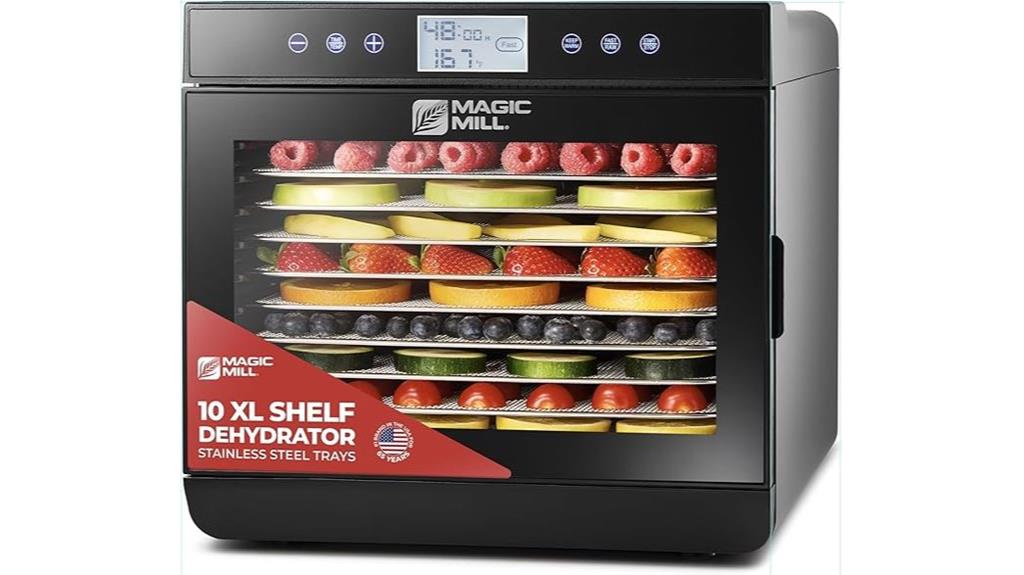
If you’re looking for an energy-efficient dehydrator that can handle large batches with ease, the Magic Mill Food Dehydrator Machine with 10 stainless steel trays is an excellent choice. Its design features a rear-mounted fan for even drying, eliminating the need to rotate trays. The transparent door lets you monitor progress without opening, and the BPA-free materials guarantee safe food contact. With a powerful 700W motor, it dries foods quickly while maintaining low noise levels. The spacious trays accommodate up to 5 pounds of food, making it ideal for home preservation. Plus, its durable build and quiet operation make it a reliable and efficient kitchen tool.
Best For: home food preservers and busy households seeking a large-capacity, energy-efficient dehydrator with consistent drying performance.
Pros:
- Uniform dehydration thanks to rear-mounted fan that eliminates tray rotation.
- Large capacity of up to 5 pounds of food across 10 stainless steel trays.
- Quiet operation combined with durable, food-safe BPA-free materials for reliable use.
Cons:
- Slightly noisy during button presses or alarm notifications.
- High-temperature settings above 165°F may cause warping; careful temperature management required.
- Dimensions and weight may require dedicated storage space and handling.
Magic Mill Pro Food Dehydrator Machine with 7 Stainless Steel Trays

The Magic Mill Pro Food Dehydrator Machine with 7 Stainless Steel Trays stands out for its large capacity and versatile tray options, making it an excellent choice for those who want to dehydrate multiple types of foods at once. Its design includes spacious stainless steel trays, including specialized fruit roll and mesh trays for small items like nuts and herbs. The BPA-free, food-grade construction guarantees safety and durability, while the transparent door window lets me monitor progress easily. With a rear-mounted fan for even heat distribution and a digital thermostat for precise control, it’s efficient and user-friendly—perfect for preserving, snacking, and experimenting with various dehydrated foods.
Best For: home cooks and food preservation enthusiasts who want a large-capacity, versatile dehydrator for drying a variety of foods efficiently and safely.
Pros:
- Spacious stainless steel trays and specialized options like fruit roll and mesh trays accommodate multiple food types at once.
- Even heat distribution and precise temperature control ensure consistent dehydration results.
- Durable, BPA-free stainless steel construction with easy-to-clean, dishwasher-safe trays and a transparent door for monitoring.
Cons:
- The large size may require ample storage space and might be less suitable for small kitchens.
- Digital controls and features could have a learning curve for some users.
- Higher price point compared to basic dehydrator models due to its advanced features and capacity.
Food Dehydrator with 12 Trays, 850W Electric Food Dryer
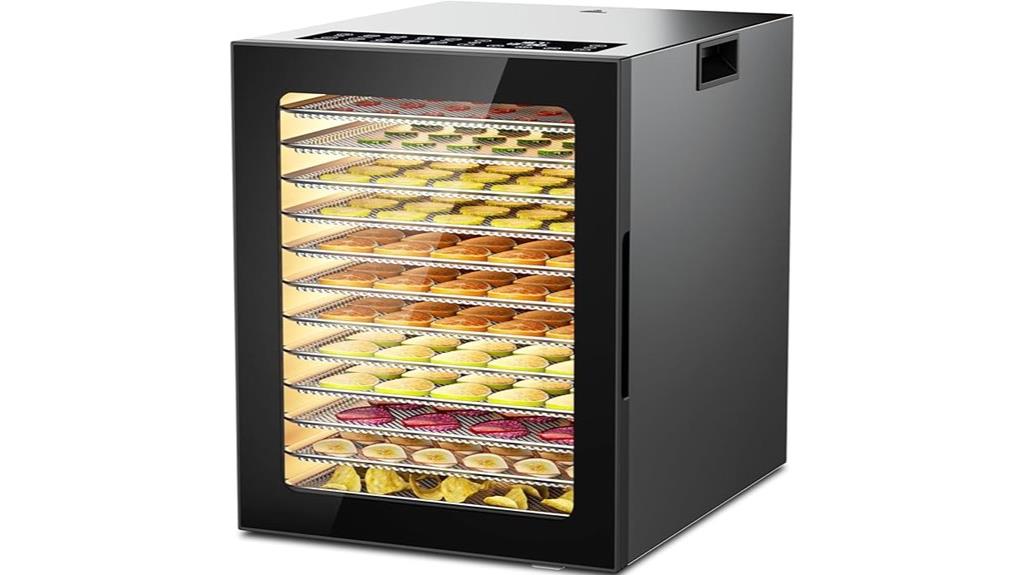
A standout feature of the Food Dehydrator with 12 Trays and 850W power is its large capacity, making it ideal for drying big batches of fruits, meats, or herbs efficiently. Its stainless steel construction guarantees durability, while dishwasher-safe trays make cleanup a breeze. The modern, compact design with a transparent glass door and interior light lets me monitor progress without opening it. With quiet operation at 55dB and even airflow from the rear-mounted fan, it dries food uniformly, saving time and energy. The precise temperature control and adjustable timer let me customize settings for different foods, ensuring nutrient preservation and flavor.
Best For: home cooks, health enthusiasts, and families seeking efficient, large-capacity food dehydration for fruits, meats, herbs, and vegetables.
Pros:
- Large 12-tray capacity ideal for batch drying of various foods
- Durable stainless steel construction with dishwasher-safe trays for easy cleaning
- Quiet operation at 55dB with even airflow for uniform drying results
Cons:
- Slightly bulky dimensions may require dedicated storage space
- Price point may be higher compared to smaller or less powerful dehydrators
- Limited to 120V power, may not be compatible in some regions without an adapter
Magic Mill Food Dehydrator Machine with 5 Trays
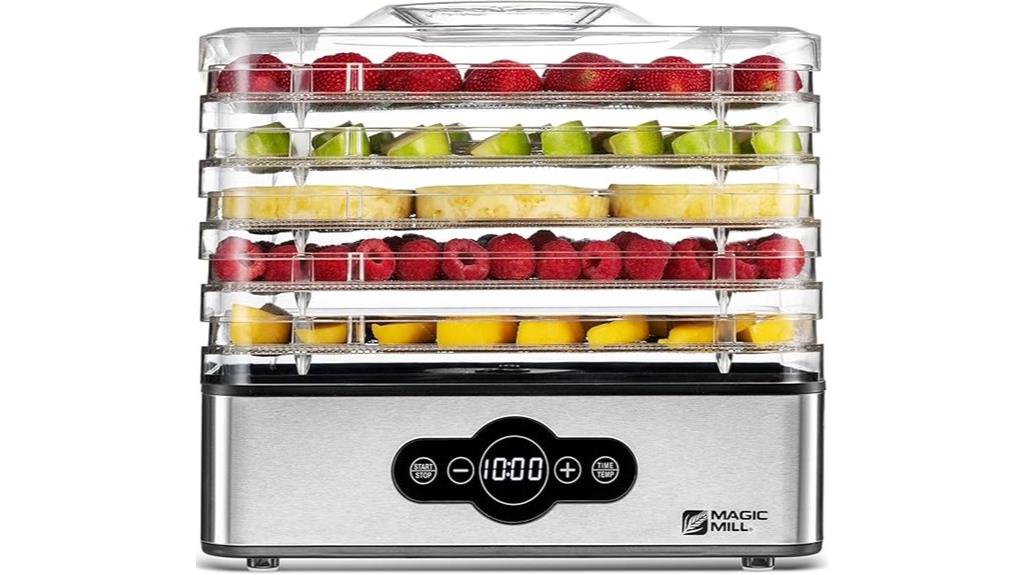
The Magic Mill Food Dehydrator Machine with 5 Trays stands out for its efficient drying power, utilizing only 240W to preserve up to 97% of vitamins and minerals. Its five adjustable, food-grade stainless steel trays accommodate various foods, including thick-cut ingredients, with heights adjustable from 0.6 to 1.1 inches. The sleek, compact design combines BPA-free plastic and a stainless steel base, making it suitable for small kitchens. Easy-to-use controls allow precise temperature (95-158°F) and timer settings, while detachable trays simplify cleaning. Despite some concerns about build quality and stability, most users find it effective for drying fruits, vegetables, meats, and herbs.
Best For: home cooks and small-scale food preservation enthusiasts seeking an affordable, easy-to-use dehydrator for drying fruits, vegetables, meats, and herbs.
Pros:
- Efficient drying with 240W power that preserves up to 97% of nutrients
- Adjustable stainless steel trays that accommodate thick ingredients and allow for even dehydration
- Compact, lightweight design suitable for small kitchens and easy cleaning
Cons:
- Build quality concerns such as tray fragility and rattling during operation
- Limited stability and potential safety issues like electrical odors or malfunctions
- Short power cord and slower drying speed compared to higher-end models
Elite Gourmet Food Dehydrator with 11.4 Trays and Adjustable Temperature

Elite Gourmet’s Food Dehydrator with 11.4 trays and adjustable temperature is ideal for home users who want efficient, versatile drying. It features five BPA-free trays, a temperature range from 95°F to 158°F, and a 350W motor that guarantees quick, even drying without tray rotation. The large viewing window helps monitor progress, while dishwasher-safe, stackable trays make cleanup simple. Its compact size fits easily on countertops, and the aluminum construction assures food safety. Perfect for drying fruits, herbs, meats, and more, this dehydrator offers customizable settings and reliable performance, making it a top choice for healthy, energy-efficient snacking at home.
Best For: home food enthusiasts, hobbyists, and pet owners seeking an efficient, versatile dehydrator for healthy snacks and food preservation.
Pros:
- Adjustable temperature control from 95°F to 158°F for versatile drying options
- Compact size with large viewing window for easy monitoring and space-saving storage
- Dishwasher-safe, stackable trays that are easy to clean and customize for various foods
Cons:
- Some users find the trays to feel flimsy and susceptible to damage with heavy use
- Occasional uneven drying reported with certain sticky or dense foods
- Limited to home use, with a 1-year warranty and manufacturing in China
Food Dehydrator for Jerky, 12-Trays
https://m.media-amazon.com/images/I/81gYSt0fKgL._AC_SX679_.jpg
With its 12 stainless steel trays and spacious 30-liter capacity, this food dehydrator is perfect for anyone wanting to make large batches of jerky efficiently. Its all-steel housing guarantees durability, while the transparent glass door and interior light let you monitor progress without heat loss. The unit operates quietly at 55dB, so it won’t disturb your day. Powered by an 850W heating element and rear-mounted turbo fan, it dries foods up to 30% faster with even airflow. Fully customizable temperatures from 95°F to 167°F and preset programs make dehydration simple. Overall, it’s an ideal choice for home cooks and small food businesses seeking reliable, energy-efficient performance.
Best For: home cooks, health enthusiasts, and small food businesses seeking efficient, large-capacity dehydration for jerky, fruits, herbs, and vegetables.
Pros:
- Large 30L capacity with 12 stainless steel trays for batch processing
- Fast and even drying thanks to 850W power and rear-mounted turbo fan
- User-friendly digital controls with preset programs and adjustable temperature and time
Cons:
- Relatively heavy at 16.31 pounds, which may require assistance for movement
- Slightly higher energy consumption due to high wattage (850W)
- May be larger in footprint, requiring sufficient storage space
CROWNFUL Food Dehydrator Machine with 7 Trays
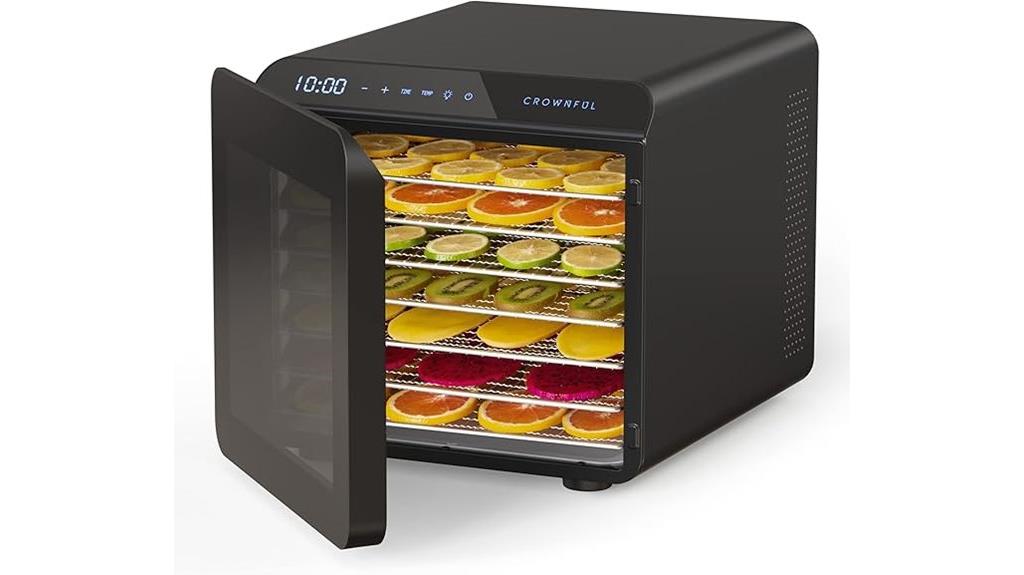
If you’re looking for an efficient dehydrator that balances performance with energy savings, the CROWNFUL Food Dehydrator Machine with 7 Trays is an excellent choice. It features 600W power, a rear-mounted fan, and 360° hot air circulation for even drying, speeding up the process and reducing energy use. The digital touchscreen controls allow precise temperature adjustments from 85-165℉ and a timer up to 48 hours. Made with BPA-free food-grade materials, it’s safe and durable. The sleek design, awarded the IF Design Award 2022, fits modern homes. Its quiet operation and easy-to-clean trays make dehydrating fruits, herbs, and meats simple, efficient, and eco-friendly.
Best For: health-conscious home cooks, hobbyists, and those seeking energy-efficient, versatile food dehydration solutions.
Pros:
- Efficient 600W power with 360° hot air circulation for even drying results
- Sleek, award-winning design that complements modern home aesthetics
- Quiet operation and easy-to-clean, BPA-free stainless steel trays
Cons:
- Initial odors may require multiple runs to eliminate
- Some users experience minor gaps in the magnetic door closure
- Lacks confirmation sounds or lights for setting adjustments, which can cause operational confusion
Yabano Food Dehydrator Machine for Home Use
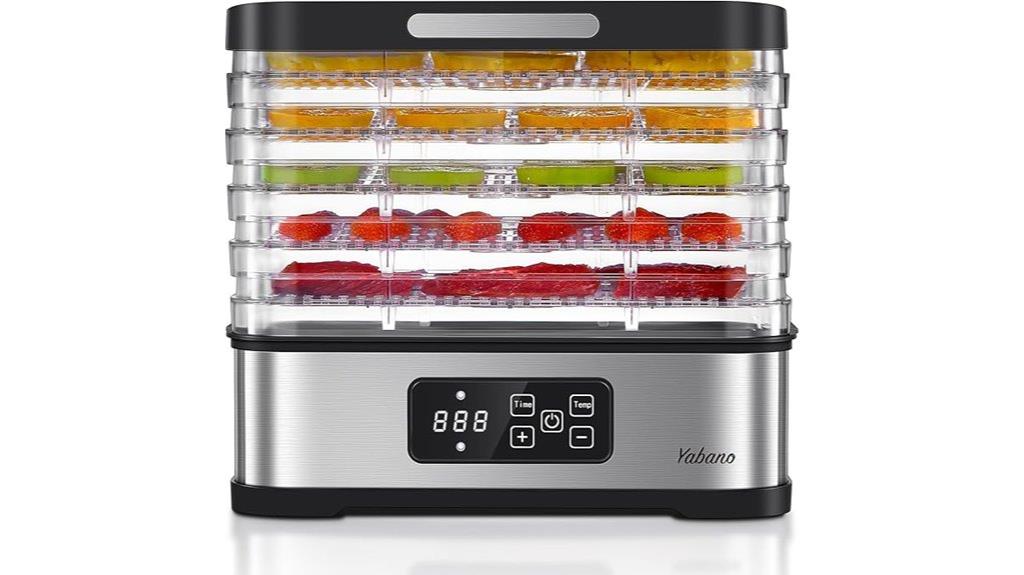
The Yabano Food Dehydrator Machine stands out as an excellent choice for home users who want to preserve food efficiently while saving energy. Its 250W motor and adjustable timer (1-72 hours) make dehydration precise and energy-conscious. With five removable trays, you can dry large batches without cluttering your countertop. The top-mounted fan ensures even heat circulation, speeding up the process and reducing energy use. Safety features like overheating protection, auto-shutoff, and child-safe locks provide peace of mind. BPA-free trays and user-friendly digital presets make it easy to create healthy snacks like jerky, herbs, and fruit while maintaining nutritional quality.
Best For: home food enthusiasts seeking an energy-efficient, versatile dehydrator to make healthy snacks and preserve food in bulk with safety and ease of use.
Pros:
- Adjustable timer (1-72 hours) and temperature control for precise dehydration.
- Large capacity with 5 removable trays for bulk drying and space-saving.
- Safety features like overheating protection, auto-shutoff, and child locks enhance user safety.
Cons:
- Limited to 250W power, which may result in longer drying times for certain foods.
- Digital presets are helpful but may require manual adjustments for some recipes.
- The dehydrator’s size might be less suitable for very small kitchens with limited counter space.
Food Dehydrator Dryer with 5 Racks and Tray
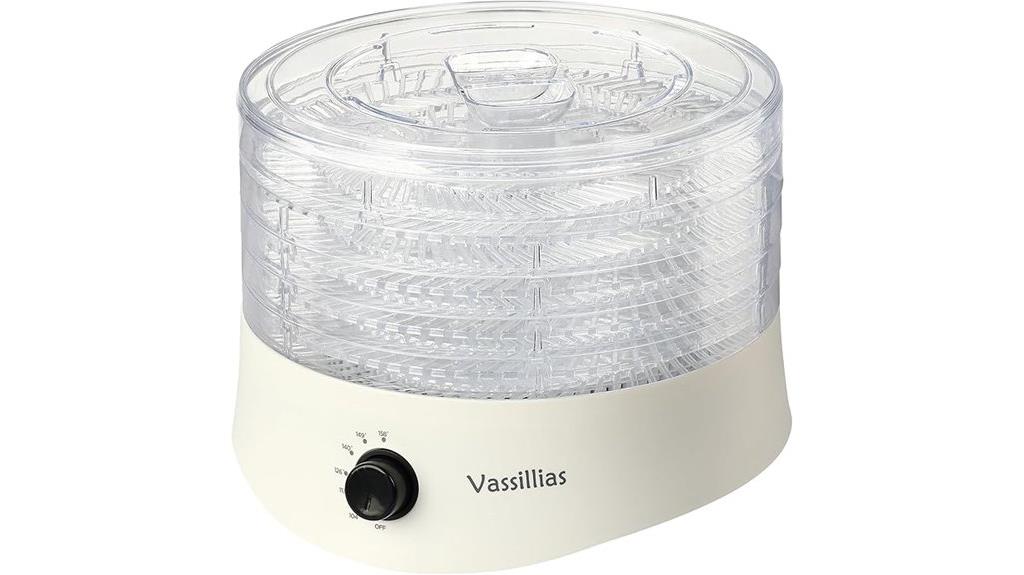
The Food Dehydrator Dryer with 5 Racks and Tray stands out for its efficient airflow and adjustable temperature controls, making it ideal for small-scale dehydration projects. Its five BPA-free, food-grade plastic trays provide ample space, with 0.79-inch gaps for superior air circulation. Compact and lightweight at just 3.74 pounds, it fits easily on countertops. The powerful fan ensures even drying, while temperature adjustable from 104°F to 158°F offers precise control. Users appreciate its quiet operation and straightforward cleaning, making it perfect for dehydrating fruits, vegetables, or jerky in limited spaces. Overall, it’s a reliable, energy-efficient choice for home snack prep.
Best For: small-scale home cooks and hobbyists seeking an affordable, compact dehydrator for fruits, vegetables, and jerky.
Pros:
- Compact and lightweight design fits easily on countertops and limited spaces
- Adjustable temperature control from 104°F to 158°F for versatile drying needs
- Quiet operation and straightforward cleaning enhance user experience
Cons:
- Not dishwasher safe, requiring manual cleaning of trays
- Cracked lids from accidental drops may affect durability
- Limited size makes it less suitable for large dehydration projects
Food Dehydrator with 12 Trays, Timer & Temp Control, Stainless Steel
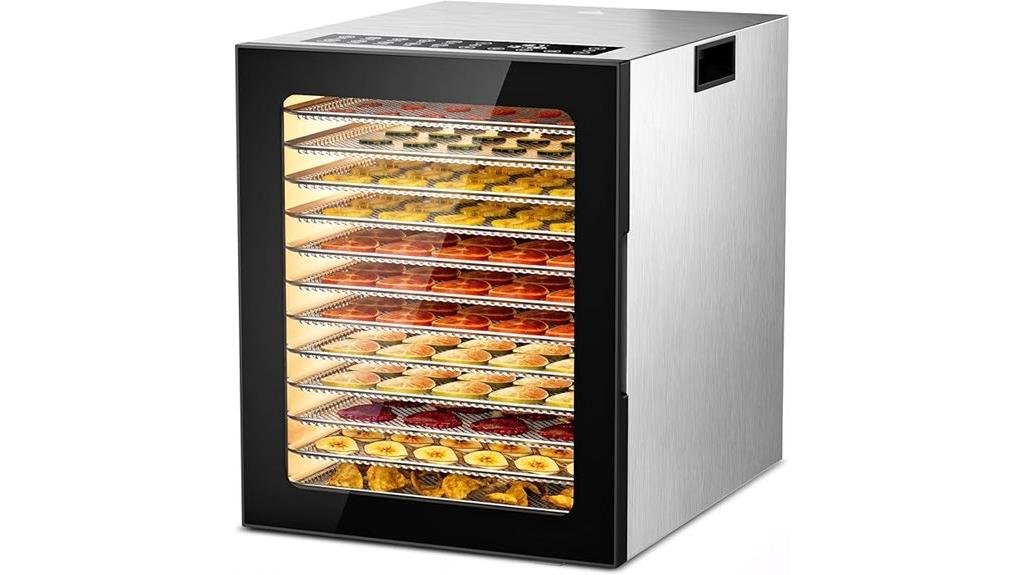
A food dehydrator with 12 stainless steel trays, a precise timer, and adjustable temperature settings offers the perfect solution for those seeking efficiency and large capacity. Its 30L space makes it ideal for both home and commercial use, while the glass door with interior light lets you monitor progress easily. The rear fan guarantees even, fast drying with quiet operation, powered by 850W for quick results. Built with a durable stainless steel body and BPA-free trays, it prioritizes safety and quality. Digital presets and customizable settings make dehydration simple, allowing you to preserve fruits, meats, and herbs efficiently while reducing food waste.
Best For: home cooks, food preservation enthusiasts, and small-scale commercial users seeking efficient, large-capacity dehydration solutions.
Pros:
- Large 30L capacity with 12 stainless steel trays for versatile dehydration of various foods simultaneously.
- Digital touchscreen with preset programs, adjustable temperature, and timer for easy, customizable operation.
- Even and quiet drying thanks to rear fan design, with durable stainless steel construction and safety features like overheat protection.
Cons:
- Relatively heavy at 16.31 pounds, which may impact portability.
- Larger size may require more storage space and may not be suitable for very small kitchens.
- Higher power consumption at 850W might increase energy costs during extended use.
Ronco Turbo EZ-Store 5-Tray Dehydrator with Convection Air Flow
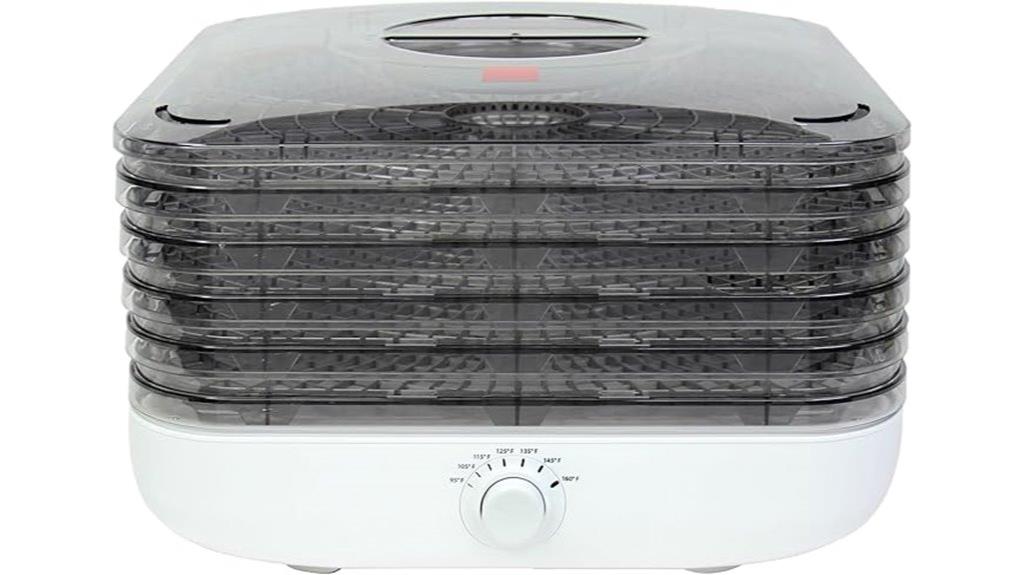
If you’re looking for an energy-efficient dehydrator that’s perfect for small kitchens or outdoor use, the Ronco Turbo EZ-Store 5-Tray Dehydrator with Convection Air Flow stands out. It features five clear, stackable trays that are easy to monitor and nest for compact storage. With a 100-watt motor and convection fan, it dries food 2-3 times faster than traditional dehydrators. Adjustable temperatures from 95°F to 160°F let you customize for different foods. Its lightweight, dishwasher-safe design makes cleanup simple, and its portable size makes it ideal for camping, outdoor activities, or small kitchens, all while consuming minimal energy.
Best For: Home cooks, outdoor enthusiasts, and small kitchens seeking an energy-efficient, easy-to-use dehydrator for drying fruits, herbs, meats, and snacks.
Pros:
- Compact, lightweight design with nestable trays for easy storage and portability
- Fast and even drying thanks to convection air flow and adjustable temperature control
- Dishwasher-safe trays and lid simplify cleanup and maintenance
Cons:
- Longer drying times may be needed for certain foods in humid environments
- Limited capacity with only five trays, which may be insufficient for large batches
- Some users find the temperature range less precise compared to more advanced models
Commercial Food Dehydrator with 18 Trays and 1500W Capacity
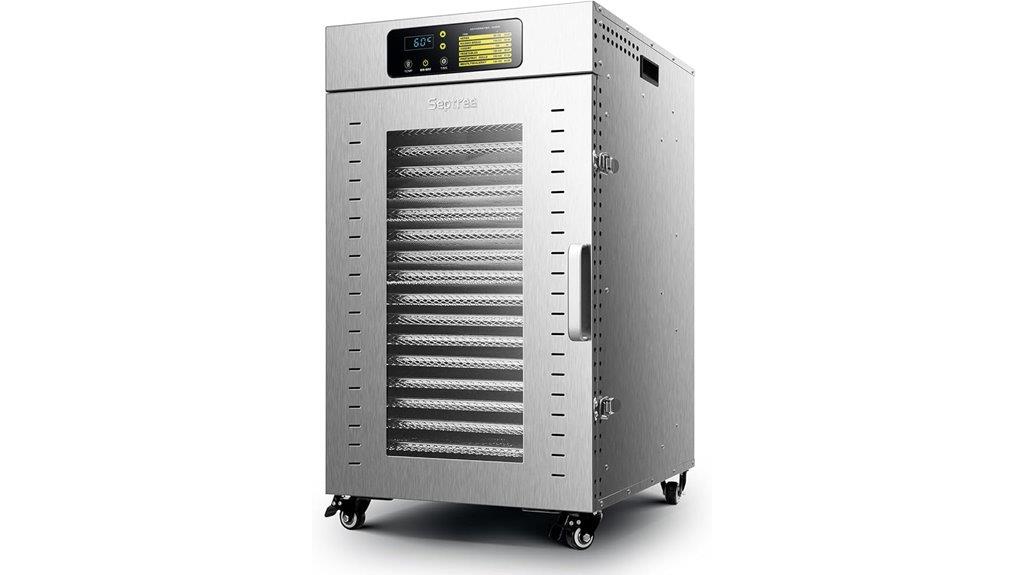
With 18 stainless steel trays and a powerful 1500W capacity, this commercial food dehydrator is ideal for those who need to process large batches efficiently. Its generous drying space—over 34 square feet—makes it perfect for commercial kitchens or serious home users. The food-grade, BPA-free construction guarantees safety and durability, while dishwasher-safe trays simplify cleaning. The digital control panel allows precise temperature settings from 70°F to 190°F and a timer up to 24 hours. Its horizontal airflow provides even heat distribution, eliminating the need for tray rotation. Overall, it’s a robust, high-capacity dehydrator designed for consistent, energy-efficient drying of fruits, meats, herbs, and more.
Best For: large-scale food processing enthusiasts, commercial kitchens, and serious home users seeking efficient, high-capacity dehydration.
Pros:
- Massive drying space with 18 stainless steel trays for large batches
- Precise digital control with adjustable temperature and timer settings
- Durable, food-grade stainless steel construction that is easy to clean and built to last
Cons:
- Longer drying times compared to smaller models due to its size and heat distribution
- Potential for overheating or fan noise issues, requiring proper maintenance
- Higher initial cost and larger footprint, which may not suit small or space-limited environments
Food Dehydrator Machine with Temperature Control and BPA-Free Trays

The Food Dehydrator Machine with Temperature Control and BPA-Free Trays stands out for its precise temperature adjustment and safe, dishwasher-safe trays, making it ideal for health-conscious users who want easy, efficient dehydration. Its adjustable thermostat from 95℉ to 167℉ allows me to tailor drying conditions for different foods, while the five stackable BPA-free trays guarantee safe, hassle-free cleaning. The compact design fits easily on my countertop or outdoors, and the LED digital control panel simplifies operation with clear time and temperature displays. Overall, it’s a reliable, energy-efficient choice for making healthy snacks like fruit chips and jerky at home.
Best For: health-conscious home cooks who want an easy, versatile, and compact dehydrator for making snacks like fruit chips and jerky.
Pros:
- Precise temperature control from 95℉ to 167℉ for tailored drying conditions
- BPA-free, dishwasher-safe trays ensure safe and hassle-free cleaning
- Compact, sleek design suitable for countertop or outdoor use
Cons:
- 250W power may lead to longer drying times, sometimes exceeding instructions
- Limited temperature adjustment increments of 9 degrees reduce fine-tuning options
- Longer dehydration durations may require tray rotation for even results
COSORI Food Dehydrator with 5 Trays and 165°F Temperature Control
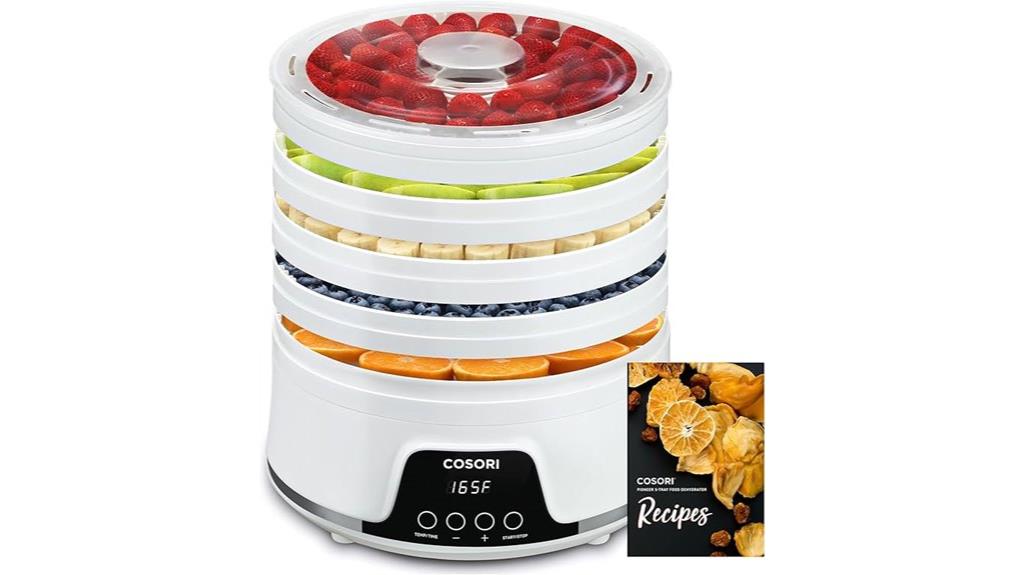
The COSORI Food Dehydrator with 5 trays and 165°F temperature control stands out for its precise temperature adjustments, making it ideal for those who want efficient drying while conserving energy. Its adjustable range from 95°F to 165°F in 1°F increments ensures superior results for various foods, from herbs to jerky. With a quiet operation below 47 dB and a 350W power draw, it’s energy-efficient. The digital touch-control LED display simplifies temperature and timer settings, while BPA-free trays are dishwasher safe and expandable up to 7 layers. Its even hot air circulation guarantees consistent drying, making it a versatile, safe, and user-friendly choice for home food preservation.
Best For: home cooks and preservation enthusiasts seeking precise temperature control, large capacity, and versatile food dehydration in a quiet, energy-efficient unit.
Pros:
- Precise temperature control from 95°F to 165°F in 1°F increments for tailored drying results
- Large, expandable trays (up to 7) with dishwasher-safe, BPA-free materials for easy cleaning and increased capacity
- Quiet operation below 47 dB and automatic safety features like shutoff and overheat protection
Cons:
- Some users report units stopping unexpectedly or malfunctioning after initial use
- Potential issues with tray gaskets or design flaws in certain batches that may pose safety concerns
- Limited color options and overall design may not suit all kitchen aesthetics
Factors to Consider When Choosing Food Dehydrators Energy Saving
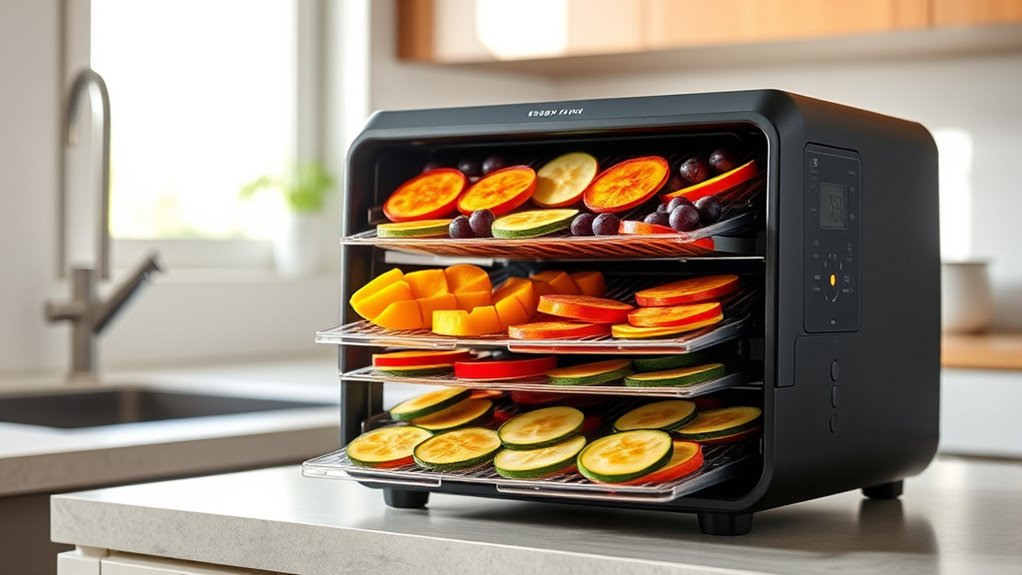
When choosing an energy-saving food dehydrator, I consider factors like power consumption levels and how efficiently the trays use space. Accurate temperature regulation and effective airflow are also vital for consistent results without wasting energy. Additionally, I look at dehydration speed to find a model that balances efficiency with time.
Power Consumption Levels
Choosing a food dehydrator with lower power consumption can substantially reduce your energy bills and environmental impact. Models with around 250-350W typically use less energy than those exceeding 800W, saving you money over time. Efficient airflow and heat distribution also matter, as they shorten drying times and lower overall energy use. It’s important to use the dehydrator at the right temperature, because unnecessary heating wastes energy. Features like automatic shut-off and timers further enhance efficiency by turning off the device once drying is complete. Energy-efficient dehydrators are designed to perform well at lower power levels without sacrificing dehydration quality. By focusing on power consumption levels, you can pick a device that’s both effective and eco-friendly, making your snacking habits more sustainable.
Tray Efficiency Design
Ensuring tray efficiency design plays a crucial role in maximizing energy savings in food dehydrators. When trays promote even airflow, dehydration becomes more uniform, reducing the need to rotate trays and saving energy. Adjustable or larger gaps between trays improve air circulation, speeding up drying times and enhancing consistency. The materials used, like stainless steel or BPA-free plastics, influence heat transfer efficiency and simplify cleaning, which can lower energy use over time. Features like mesh inserts or specialized liners help dry small or delicate foods faster, further reducing energy consumption. Additionally, design elements such as stackability, modularity, and tray size impact the unit’s capacity and efficiency during batch processing. A well-designed tray system ensures optimal airflow and energy use, making dehydration quicker and more cost-effective.
Temperature Regulation Accuracy
Have you ever experienced uneven drying or found your food overcooked despite following recommended settings? That’s often due to imprecise temperature regulation. A dehydrator with accurate temperature control ensures consistent results and prevents over- or under-drying, which saves energy by avoiding unnecessary extended operation. Digital thermostats with fine control—like adjustable in 1°F increments—allow me to set ideal temperatures for different foods, reducing waste. Overly high temperatures can cause uneven drying and waste energy, so precise regulation helps maintain perfect settings. Some models even feature automatic calibration or sensors that adjust heat in real-time, boosting efficiency and reliability. Accurate temperature regulation minimizes the need for tray rotation and longer drying times, further conserving energy during the dehydration process.
Airflow Circulation Method
Effective airflow circulation is essential for energy-efficient food dehydration because it guarantees even heat distribution and consistent drying results. Dehydrators with rear-mounted or bottom-mounted fans promote uniform airflow across all trays, preventing hot spots and uneven drying. Horizontal airflow systems are especially beneficial—they eliminate the need for tray rotation, which speeds up dehydration and enhances consistency. Some models feature 360° hot air circulation technology, enveloping food with steady airflow from all directions for uniform drying. Well-designed airflow systems also operate quietly, often around 50-55dB, showing they’re efficient without being noisy. Proper airflow design not only improves dehydration quality but also reduces energy consumption by avoiding excess drying time caused by poor circulation. This makes airflow method a critical factor when selecting an energy-saving food dehydrator.
Dehydration Speed
When considering dehydration speed, wattage plays a significant role. Higher wattage dehydrators, like those with 850W or more, can cut down drying times, especially for large batches. An efficient airflow system, such as rear-mounted or turbo fans, ensures faster, more uniform drying across all trays. Advanced airflow technology that eliminates the need for tray rotation maintains consistent heat distribution, boosting speed. Additionally, higher temperature settings—up to 167°F or 190°F—enable quicker moisture removal, but I recommend balancing temperature to prevent food quality loss. The number of trays and their arrangement also impact dehydration speed. Larger capacity models can process more food simultaneously, but inadequate airflow might extend total drying time. Overall, wattage and airflow are key to faster dehydration while maintaining energy efficiency.
Material Insulation Quality
Choosing a food dehydrator with high-quality insulation can greatly reduce your energy bills and guarantee more consistent drying results. Good insulation minimizes heat loss, so the dehydrator uses less power to maintain stable temperatures. Materials like foam or mineral wool are particularly effective at improving thermal efficiency. They help keep heat inside, preventing it from escaping and reducing the need for prolonged or high-temperature cycles. Poor insulation causes more heat to escape, forcing the dehydrator to work harder and consume more energy. The thickness and density of the insulation also matter; thicker, denser materials provide better energy conservation. Investing in a unit with superior insulation not only saves you money but also ensures your snacks dry evenly and efficiently.
Adjustable Settings Flexibility
Adjustable settings play a crucial role in enhancing a food dehydrator’s energy efficiency, as they allow me to fine-tune the drying process to suit specific foods and conditions. Precise temperature controls, usually between 95°F and 167°F, help me optimize energy use based on what I’m dehydrating. Digital timers enable me to set exact drying durations, avoiding unnecessary energy consumption. Some models come with preset programs for different foods, which simplifies the process and saves energy by optimizing cycles. Variable fan speeds and airflow settings let me adjust for moisture content and quantity, ensuring efficient drying. Additionally, trays with customizable stacking and adjustable heights help maximize space, reducing the need for multiple cycles and conserving energy. These flexible settings make dehydration more efficient and tailored.
Energy Saving Features
Energy-saving food dehydrators incorporate features designed to minimize power consumption while maintaining effective drying performance. They often have low wattage motors and efficient airflow systems that reduce energy use without sacrificing efficiency. Adjustable temperature controls let you set the ideal drying temperature, avoiding high heats that waste energy. Dehydrators with multiple trays and faster drying times cut down on overall energy expenditure by completing tasks more quickly. Some models include automatic shut-off or sleep modes, preventing unnecessary power drain once drying is finished. Proper insulation and well-designed airflow channels help maintain consistent temperatures, reducing energy waste and increasing efficiency. By choosing dehydrators with these features, you can enjoy delicious, healthy snacks while keeping your energy bills low.
Frequently Asked Questions
How Does Dehydration Time Impact Energy Efficiency?
Dehydration time directly impacts energy efficiency because longer drying periods consume more electricity. When I use my dehydrator, I notice that shorter cycles save power while still preserving the food’s quality. By choosing a dehydrator with adjustable temperature and timing, I can optimize energy use, reducing waste. Quick, efficient dehydration not only saves energy but also helps me snack healthier and more sustainably.
Are There Eco-Friendly Materials Used in Dehydrator Construction?
When it comes to dehydrator construction, I look for models made from eco-friendly materials like BPA-free plastics, recycled metals, and sustainable plastics. These materials reduce environmental impact and guarantee safety. I prefer brands committed to sustainability, as they often use environmentally conscious manufacturing practices. Choosing dehydrators with eco-friendly components not only helps the planet but also provides peace of mind knowing I’m making a responsible choice.
What Is the Average Power Consumption per Dehydration Cycle?
You’re wondering about the average power consumption per dehydration cycle. I’ve found that most modern dehydrators use between 300 to 600 watts during operation. A typical cycle lasts about 8 to 12 hours, so I estimate the total energy used ranges from 2.4 to 7.2 kilowatt-hours. This info helps me choose efficient models and save energy while preparing healthy snacks.
Can Dehydration Settings Be Optimized for Lower Energy Use?
Absolutely, dehydration settings can be optimized for lower energy use. I recommend starting with the lowest temperature that effectively dries your food since higher settings consume more power. Additionally, reducing the dehydration time by preparing thin, uniform slices helps conserve energy. Using a timer or smart features on your dehydrator can also prevent unnecessary energy consumption. Small adjustments like these make a noticeable difference in saving energy during each cycle.
Do Energy-Saving Features Vary Between Models?
When I look at dehydration appliances, I notice that energy-saving features do vary between models. Some have adjustable temperature controls, timers, and insulated exteriors to minimize power use. Others include smart technology that optimizes drying cycles for efficiency. I recommend checking each model’s specs to find those with eco-friendly features, as this can make a significant difference in energy consumption and overall savings during dehydration.
Conclusion
Choosing the right energy-saving food dehydrator is like finding the perfect recipe—it takes a little trial, but the results are worth it. I once tried a basic model that drained more energy than I expected, reminding me how essential efficiency is. With so many options, I’ve learned that investing in a well-designed dehydrator not only saves power but also makes healthy snacking easier. Think of it as nurturing your habits, one efficient snack at a time.






